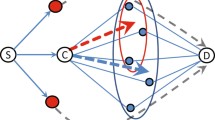Abstract
This paper proposes an instantaneous recovery route design scheme using multiple coding-aware link protection scenarios to achieve higher link cost reduction in the network. In this scheme, two protection scenarios, namely, (i) traffic splitting (TS), and (ii) two sources and a common destination (2SD) are used to integrate multiple sources and a common destination. The proposed scheme consists of two phases. In the first phase, the proposed scheme determines routes for 2SD and TS scenarios of all possible source-destination pairs to minimize the total link cost. In this phase, the network coding is applied to the common path within each scenario, individually. In the second phase, network coding is applied to the common path between two scenarios (or a scenario pair) in order to enhance the resource saving. This phase develops conditions that select the most appropriate combination of scenario pairs, such as TS–TS, 2SD–2SD, and 2SD–TS for network coding, including their proofs. Using these conditions, a heuristic algorithm is introduced in order to select the most appropriate combination of scenario pairs for further enhancing of resource saving. Simulation results show that the proposed scheme outperforms the conventional 1 + 1 protection scheme, the TS scenario, and the 2SD scenario in terms of link cost reduction in the network.










Similar content being viewed by others
References
Fawaz, W., & Chen, K. (2010). Survivability-oriented quality of service in optical networks. End-to-End Quality of Service Engineering in Next Generation Heterogenous, 197–211.
Simmons, J. M. (2012). Catastrophic failures in a backbone network. IEEE Communications Letters, 16(8), 1328–1331.
Kodialam, M., & Lakshman, T. (2003). Dynamic routing of restorable bandwidth-guaranteed tunnels using aggregated network resource usage information. IEEE/ACM Transactions on Networking, 11(3), 399–410.
Ahlswede, R., Cai, N., Li, S. Y. R., & Yeung, R. W. (2000). Network information flow. IEEE Transactions on Information Theory, 46(4), 1204–1216.
Muktadir, A., Hena, A., & Oki, E. (2014). A heuristic routing algorithm with erasure correcting code based instantaneous recovery technique. In: 2014 IEEE International Conference on Communications (ICC), pp. 1143–1147. IEEE
Jose, A. A., Muktadir, A. H. A., & Oki, E. (2012). Network coding aware instantaneous recovery scheme based on optimal traffic splitting. IEICE Communications Express, 1(1), 28–32.
Babarczi, P., Biczók, G., Øverby, H., Tapolcai, J., & Soproni, P. (2013). Realization strategies of dedicated path protection: A bandwidth cost perspective. Computer Networks, 57(9), 1974–1990.
Al Muktadir, A.H., & Oki, E. (2015). Differential delay aware instantaneous recovery scheme with traffic splitting. International Journal of Communication Systems (to appear)
Babarczi, P., Pašić, A., Tapolcai, J., Németh, F., & Ladóczki, B. (2015). Instantaneous recovery of unicast connections in transport networks: Routing versus coding. Computer Networks, 82, 68–80.
Belzner, M., & Haunstein, H. (2009) Performance of network coding in transport networks with traffic protection. In: Photonic Networks, 2009 ITG Symposium on, pp. 1–7. VDE
Al Muktadir, A.H., & Oki, E. (2015). A coding-aware reliable route design scheme for instantaneous recovery. Telecommunication Systems (to appear)
Al Muktadir, A. H., & Oki, E. (2014). Optimum route design in 1+ 1 protection with network coding for instantaneous recovery. IEICE Transactions on Communications, 97(1), 87–104.
Muktadir, A. H. A., & Oki, E. (2012). A mathematical model for routing in 1 + 1 protection with network coding for instantaneous recovery. IEICE Communications Express, 1(6), 228–233.
Phong, P. V., Al Muktadir, A. H., & Oki, E. (2015). A hybrid instantaneous recovery route design scheme with two different coding aware scenarios. IEICE Communications Express, 4(1), 8–13.
Manley, E. D., Deogun, J. S., Xu, L., & Alexander, D. R. (2010). All-optical network coding. Journal of Optical Communications and Networking, 2(4), 175–191.
Kamal, A. E. (2010). Network protection for mesh networks: network coding-based protection using p-cycles. Networking, IEEE/ACM Transactions on, 18(1), 67–80.
Luby, M. G., Mitzenmacher, M., Shokrollahi, M. A., & Spielman, D. A. (2001). Efficient erasure correcting codes. IEEE Transactions on Information Theory, 47(2), 569–584.
Matsuda, T., Noguchi, T., & Takine, T. (2011). Survey of network coding and its applications. IEICE Transactions on Communications, 94(3), 698–717.
An, Y., Da Ros, F., & Peucheret, C. (2013). All-optical network coding for dpsk signals. In: National Fiber Optic Engineers Conference, pp. JW2A–60. Optical Society of America
Wang, Q., Zhu, G., Chen, H., Jaques, J., Leuthold, J., Piccirilli, A. B., et al. (2004). Study of all-optical xor using mach-zehnder interferometer and differential scheme. IEEE Journal of Quantum Electronics, 40(6), 703–710.
Wang, J., Chi, K., Yang, Y., & Wang, X. (2015). Network coding based on hyper-edge decomposition for wireless network with link failures. International Journal of Communication Systems, 28(7), 1387–1399.
Chen, S., Wu, M., & Lu, W. (2012). Compressed error and erasure correcting codes via rank-metric codes in random network coding. International Journal of Communication Systems, 25(11), 1398–1414.
El Rouayheb, S., Sprintson, A., & Georghiades, C. (2011). Robust network codes for unicast connections: A case study. IEEE/ACM Transactions on Networking (TON), 19(3), 644–656.
Alessandro, S. (2003) Steiner tree NP-completeness proof. Technical report, University of Trento. Retrieved March 1, 2016 from http://profs.sci.univr.it/~rrizzi/classes/Complexity/provette/Santuari/steiner.
Japan photonic network model. Retrieved March 3, 2016 from http://www.ieice.org/~pn/jpn/JPNM/.
Arakawa, S.S.T., & Tsukishima, Y. (2013). Topological characteristic of japan photonic network model. IEICE technical report, 113(91), 7–12.
Chatterjee, B. C., Sarma, N., & Sahu, P. P. (2012). Priority based routing and wavelength assignment with traffic grooming for optical networks. Journal of Optical Communications and Networking, IEEE/OSA, 4(6), 480–489.
Mahony, M. (1996). Results from the cost 239 project. ultra-high capacity optical transmission networks. In: ECOC’96. 22nd European Conference on Optical Communication 1996, vol. 2, pp. 11–18. IEEE
Acknowledgments
This work was supported in part by National Institute of Information and Communications Technology, Japan.
Author information
Authors and Affiliations
Corresponding author
Rights and permissions
About this article
Cite this article
Pham, P.V., Chatterjee, B.C., Al Muktadir, A.H. et al. Instantaneous recovery route design scheme using multiple coding-aware protection scenarios. Telecommun Syst 64, 75–85 (2017). https://doi.org/10.1007/s11235-016-0159-1
Published:
Issue Date:
DOI: https://doi.org/10.1007/s11235-016-0159-1




